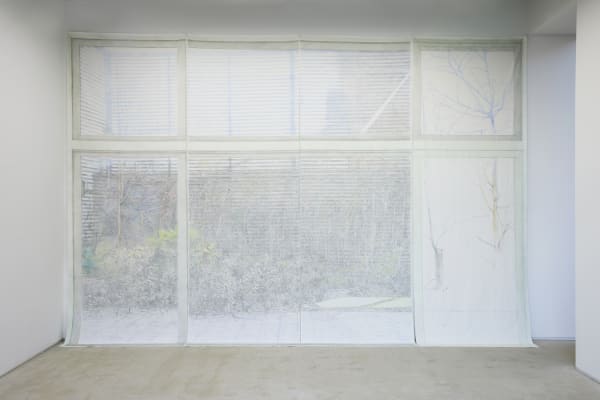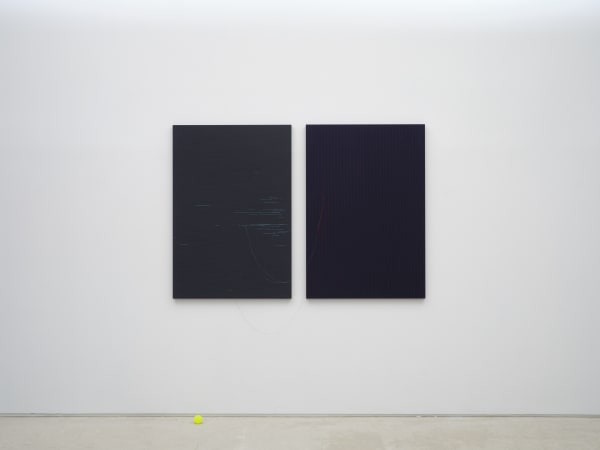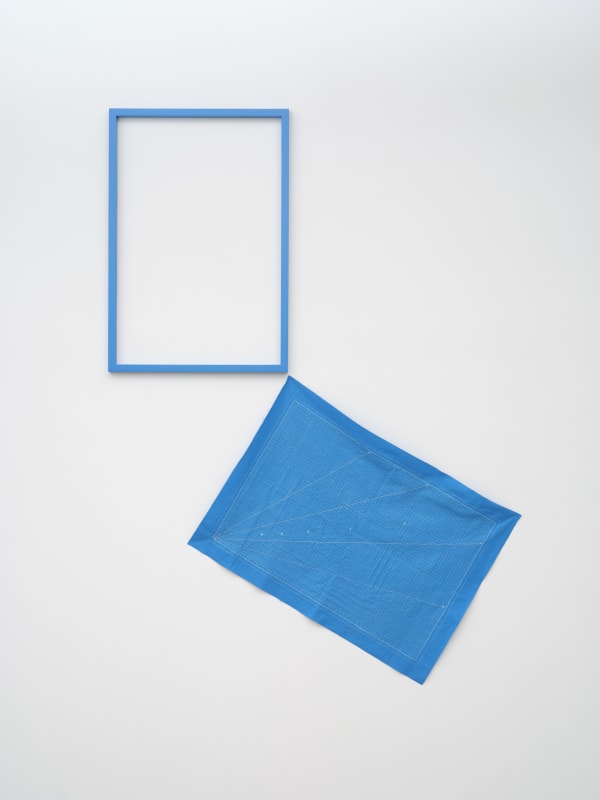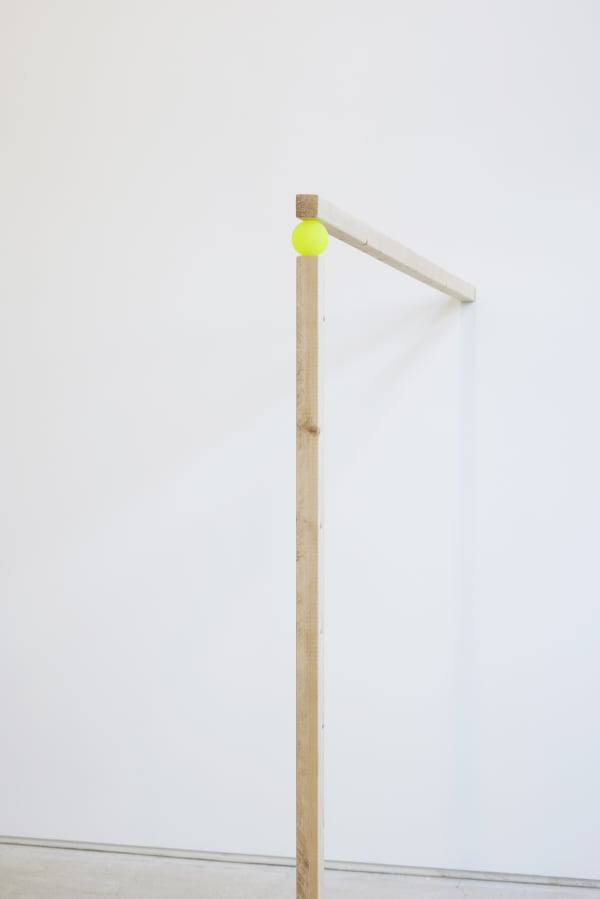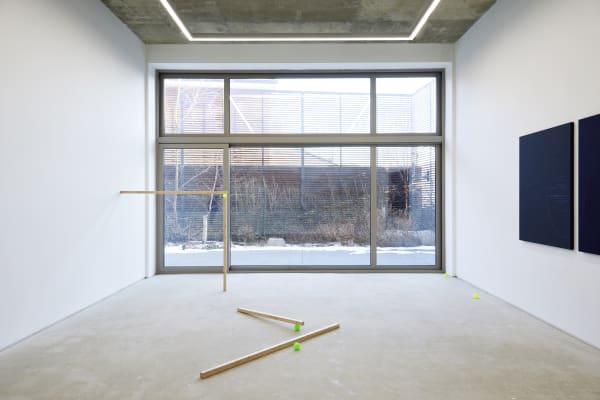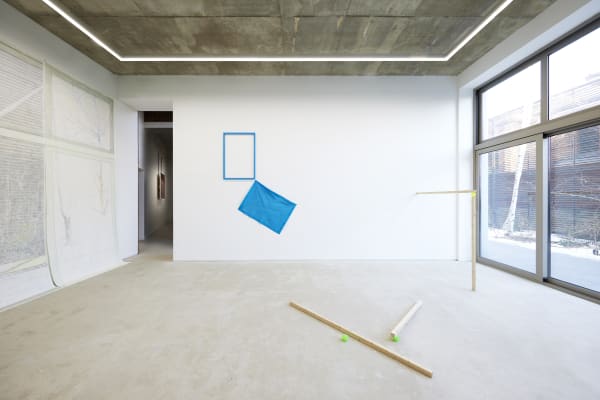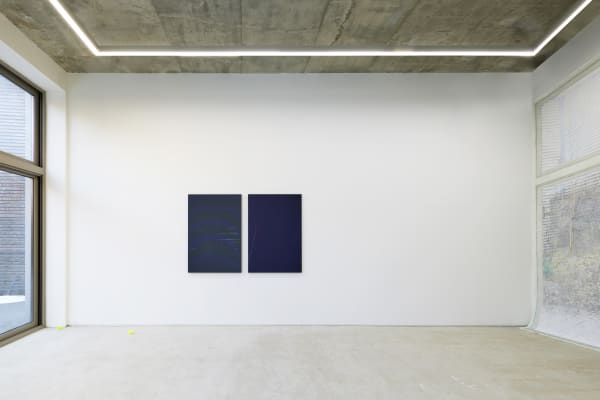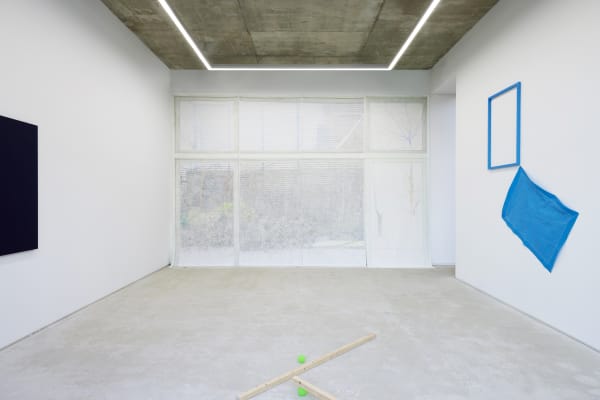나중에, 나중에, 나중에, Later, later, later,: 정철규 Choulgue Jung
정철규 개인전 <나중에, 나중에, 나중에,>는 인간이 타자를 사랑하면서 겪는 감정과 상황을 은유적으로 묘사한다. 영화 <콜 미 바이 유어 네임>(Call Me by Your Name)에서 엘리오의 첫사랑이자 그의 아버지의 조수인 올리버는 엘리오 가족과의 여름휴가를 마치고 미국으로 떠날 때, 늘 입버릇처럼 말하던 ‘나중에’(Later)라는 인사를 엘리오에게 남기지 않는다. 이뤄질 수 없는 사랑 앞에서 그는 헛된 약속을 하지 않았다. 엘리오는 아무 말 없이 떠나는 그를 보며 사랑의 끝을 예감한다. 만약 그 상황에서 올리버가 ‘나중에’라는 말을 남겼다면. 엘리오에게는 언젠가 우리는 다시 만날 수 있다는 희망의 메시지로, 그에게는 둘의 관계를 유보하는 거절의 메시지로 기억했을 것이다. ‘나중에’란 사랑에 있어서만큼은 한없이 낭만적이고 잔인한 말이다.
전시는 사랑을 주제로 한다. 여기서 ‘사랑’은 인류애나 가족애가 아닌 특정한 타자를 갈구하고 그리워하는 마음이다. 그 누구도 ‘사랑’으로부터 자유로울 수 없다. 누군가는 쉽게 사랑을 얻지만, 그 사랑이 그다지 소중하지 않을 수도 있고, 누군가는 잡고 싶어도 도저히 손에 잡히지 않을 수도 있고, 누군가는 잡았다가 놓칠 수도 있다. 정철규는 ‘사랑에는 어떤 불가능함과 불완전함이 존재한다’고 믿는다. 그저 우리는 누군가를 만났다가 헤어지고 사랑을 갈구하다가 거부한다. 그는 이처럼 인간이란 마치 어떤 무한궤도 안에 존재하고 있는 것 같다고 말한다. 그리고 그것을 전시 안에서 시적으로 보여주고 싶어 한다.
사랑을 주제로 다룬 것은 2010년 첫 개인전 때부터였다. 처음 그는 (첫) 사랑과 그로 인해 느끼는 소외의 감정을 그림으로 표현했지만 이후 바느질을 비롯해 입체와 설치로 매체를 확장했다. 작가는 하나의 화면에 이야기를 함축적으로 담아내는 회화보다 다양한 매체를 통해 주제를 분절해서 접근하는 방식을 선택한다. 그래서 전시는 주제를 파편적으로 담고 있는 작품을 나열하고 정리하는 방식이 주를 이룬다. 여기에는 돌, 화분, 원단과 같은 유형의 물질뿐만 아니라 시나 소설 속 텍스트와 같은 무형의 물질도 해당한다. 그는 하나의 큰 목소리보다는 작은 소리로 여러 번 말하는 것이 더 효과적이라고 생각한다. 마치 서로 다른 음으로 노래하고 있지만 하나의 공통된 멜로디나 법칙에 의해 아름다운 화음을 만들어내는 것처럼 말이다.
이번 전시는 4점의 작품으로 구성되어 있다. 우리는 누군가를 사랑할 때 그 상대의 말이나 행동을 유심히 관찰하게 된다. 그리고 어느새 상대의 말투나 행동을 흉내 내기도 한다. <닮아가는 벽>은 전시장 창문과 바깥의 풍경을 닮아가는 회화 작업이다. 마주 보고 있지만 거리를 좁히지는 못하고 그저 상대를 흉내만 낼 뿐이다. 그런데 창밖으로 보이는 풍경과 천 위에 그려진 풍경(흉내 낸 풍경)은 계절의 차이를 보인다. 그렇다. 우리는 닮고자 하는 대상을 쫓아가지만, 그사이 그는 또 다른 지점에 가 있다. <꽉 잡은 손>은 각자 수직과 수평으로 서 있는 두 개의 막대기가 하나의 공을 붙잡고 있다. 공을 놓치지 않기 위한 그 둘의 애틋한 마음과 언제라도 쉽게 공이 떨어질 수 있다는 불안한 기류가 동시에 감지된다. 바닥에는 두 개의 공이 긴 막대기를 받치고 있다. 작가는 관람객이 직접 어떤 상황을 만들어낼 수 있도록 했다. 그들의 사랑이 해피 엔딩일지 새드 엔딩일지는 관람객의 몫이다. <너의 등을 긁는다>는 서로 다른 패턴의 원단이 가느다란 실로 연결되어 있다. 각자의 모습은 다르지만, 상대의 가려운 등을 긁어주며 그 둘은 하나가 되고자 한다. <말하는 사람과 듣지 않는 사람>에서 커팅 매트는 말하는 사람이고 프레임은 듣지 않는 사람이다. 커팅 매트는 자신을 팽팽하게 지탱해줄 프레임이 필요하지만, 프레임은 선뜻 자기 몸을 내어주지 않는 듯하다. 사실 프레임은 그 누가 와도 상관없다. 커팅 매트 역시 프레임에 씌워진다고 해도 어차피 자기 역할을 하지 못한다. 하지만 안타깝게도 그는 이 냉정한 현실을 아직 받아들이지 못하는 것 같다.
작품들은 두 개의 사물이 짝을 이루지만 모두 온전한 하나가 되지 못하고 있다. 또한 정철규는 ‘완벽한 사랑’에 의문을 품는 만큼 작품에서도 사랑의 형태를 하나로 규정하지 않는다. 4점의 작품은 그저 각자의 어떤 상황에, 각자의 어떤 모습으로 존재할 뿐이다. 하지만 비록 불안정하고 불완전한 모습일지라도 작품이 그 나름대로 아름답길 작가는 바란다. 완벽한 사랑이 존재한다고 믿는 것, 그것을 찾으려고 애쓰는 것, 현재의 사랑이 완벽하지 못하다고 단정하는 것이 사랑의 실패 요인일지 모른다. 그러니 완벽할 수 없는 사랑에 완벽한 형태를 부여한다는 것은 어불성설이다. 하나가 되지 못하고 둘 사이의 메울 수 없는 공백이 존재하는 이 아슬아슬하고 아련한 상황이 어쩌면 사랑에 가장 ‘가까운’ 재현일 것이다.
여기서 ‘완벽한 사랑’이란 단지 마음의 문제만은 아니다. 남녀가 만나 연애하고 결혼하고 아이를 낳아 가족을 꾸리는 것이 (의식적이든 무의식적이든) 여전히 사랑의 형태로 인식되고 있다. 정철규의 작품에는 사회적인 인식의 틀에서 온전한 사랑을 이룰 수 없는 자신의 정체성이 내재되어 있다. 작가가 사랑을 주제로 오랫동안 작업을 해 온 것, 타자의 삶에 귀 기울이는 것은 ‘당신들은 어떻게 살길래 우리를 그렇게 보는 것인가?’라는 질문에 답을 찾기 위해서 였다. 그는 ‘성별, 나이, 인종, 정체성 그리고 살고 있는 시대를 떠나 사랑 앞에선 누구도 당당할 수 없다’고 말한다. 우리는 모두 최선을 다해보지만, 결국 ‘그저 그런 사랑’을 하고 있을 뿐이다. 그는 작품이 거울 같기를 바란다. 사람들이 거울 앞에 서면 거울이 아닌 그 안에 비친 자신을 보듯이 말이다. 관람객이 전시를 통해 각자의 사랑을 복기하고 작품에 공감해 주는 것은 작가에게 있어 자신을 ‘우리’로 인정하고 받아들이는 일이라고 믿고 있다. 그는 그런 믿음이 있다.
Later, Later, Later is a solo exhibition by Jung Choulgue, a metaphor on the emotional and situational encounters that come with the human experience of loving the other. Set in northern Italy in 1983, film Call Me by Your Name (2017) follows the romantic relationship between Elio and Oliver. Oliver is a graduate-student assistant to Elio's father who is a professor, who spends the summer vacation with professor’s family (and Elio) before returning to the United States at the end of summer. Young Elio is smitten by Oliver, but at the end of summer, Oliver departs without his usual “later”, reserving themselves of vain promises. The graduate student understood the reality of love that would not be fulfilled. In that silence, Elio grasps that whatever was, would no longer be. Even if Oliver departed with a vague customary “later”, Elio would have accepted it as a token of faith, of a possible future encountered together, and Oliver would have propositioned it as a deferred future together–ultimately a parting salutation. There is nothing more romantic and painfully cruel than love, later.
Jung’s solo exhibition is on the theme of love, not of philanthropy, altruism, or familial fashion, but a kind of love that is in search of, and empty in the shape of, a specific other. No person can be completely free from it. Every person encounters it in their own way. To some, love may come easy, or laden-free of burden. To some, it may seem entirely elusive while even others may have seen it come and gone. Jung Choulgue believes that ‘impossibility and imperfection are part and parcel to love’. As lovers, we simply meet, bid farewell, long for more, then reject love. And that trajectory seems to repeat and extend forever in some iterative, circular fashion, as an integral part of the human experience. That is, an experience that Jung believes can be translated visually in an exhibition.
Love was there in 2010, as the theme to the artist’s first solo exhibition. There, Jung addressed the lingering moments that follow puppy-love, and the disappointment of becoming unfamiliar with a person. His first offering was in painting only, but he soon expanded his practice to needle-and-thread, as well as sculptures and installations. His presentations forego the abstraction-via-singular-screen. Instead, he adds finer detail to a singular theme by approaching it from multiple media. As such, his exhibitions are often composed of fragmented ideas structured and ordered under an overarching theme. Those ideas may take form as rocks, potted plants, and fabrics, or be less tangible as text from prose or poetry. Soft-spoken over many occasions is more effective than a singular resonating voice that booms only once, according to Jung. This threading of voices resembling a harmonious melody that spreads across a musical score, bound together by some unseen rule.
This latest exhibition consists of four works. When we love someone, our attention becomes focused on them, and we become more observant of their words and actions. We learn more about them that way, and for the theatrically gifted, this learning can include mimicry of those very words and actions. <Walls to become resembled> is a painted work that grows resemblance to the exhibition hall windows and the scenery outside. Almost like a reflection of the other, but unable to completely collapse into one, forcing mimicry into the next best bet. Between the canvas and the window are different seasons, the canvas being the obvious mimic. And yes, we stumble after the one we wish to know better and resemble, but they are always out of reach, having fluidly moved positions. <Hands to hold tightly> is a work which includes two stick (or rod) pieces, one horizontal and the other vertical, holding a ball in-between. There is tense balance between the two stick-pieces chopstick-holding the ball and the viscerally tangible sense of slipping its grip and dropping it through. On the floor, is a different situation, where the stick is supported by two balls. Jung has set the table for how viewers might choose to experience the painting. Whether that experience leads to a happy ending with love, is entirely the choice of the viewers. <Scratching your back> is a work of differently-patterned fabrics connected by thin threading. Each fabric looks uniquely different to others, but they scratch each other’s backs and seek unity among the different. <Those who speak and those who do not listen> is a work where the cutting-mat is a talking-person and the frame is an unlistening-person. The cutting-mat requires a sturdy frame capable of supporting the mat’s lack of structural integrity, but the frame seems reticent and unwilling. In truth, for the frame, anything would do. And for the cutting-mat, an added frame does not mean improved function of its original purpose. However, he seems not to have come to terms with this rigid and unforgiving reality.
The artist’s presented works iterate on the idea of two separate things that are paired but cannot become both one and whole. Jung’s work casting the question of true love also did not define love in a singular form. The four presented works merely exist separately, each with its own situation. Although they are parts that seek to be whole, the artist hopes for each to be beautiful and come as they are. Faith in an existence of perfect love, seeking it to the repeated disappointment and detriment of imperfect love, is perhaps what causes love to fail. This situation urgent yet tender situation where two face an unbridgeable gap is an apt representation of love.
Perfect love, like anything which claims to be perfect, leads to the question of its definition. And traditionally, this perfectly formed love story (whether by waking will or the subconscious) has featured a man and a woman who meet, fall in love and marry, have children and live as a family. Jung Choulgue’s works reflect his identity which has disallowed him of such perfect and wholesome love that the broader society has come to expect. His thematic lingering on love for such an extended period of time, and his great attention for the life of the other, has both been to ask: ‘who are you/they to look at us in that way?’ “Who can claim oneself better than love, regardless of sex, age, ethnicity, and identity? None.” Says Jung. We all try our best to strike out with our best foot forward, but all that is just mediocrity in the practice of love. Jung wants his works to reflect something back to the gaze beholding it. Much like a mirror–the looking glass–where people experience their own reflection, and not the panel-shaped furniture itself. He has strong belief that allowing the viewing gaze to identify their own stories reflecting back at them would be a way of finding acceptance as part of us. And he is a present believer, not later.
